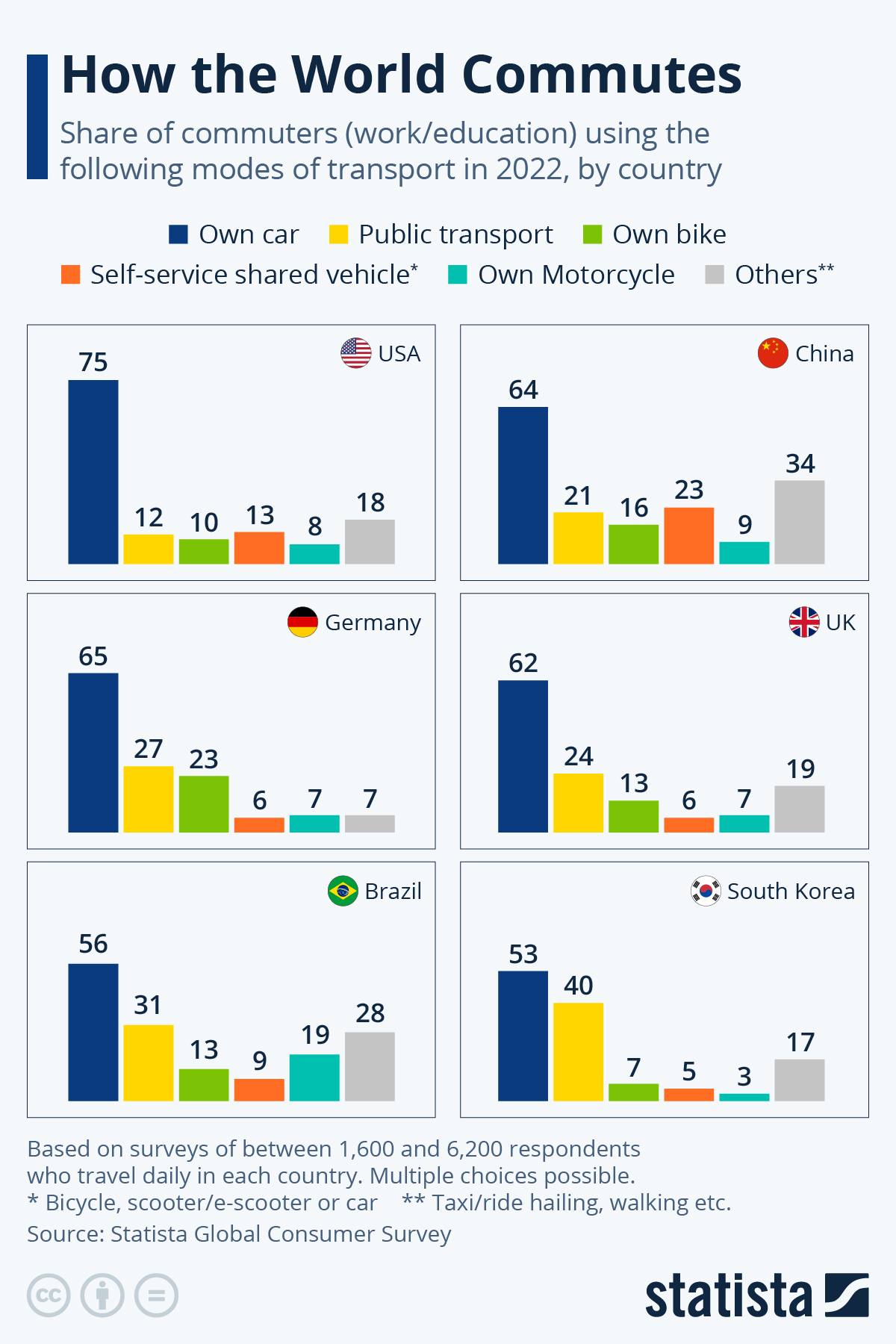Another demonstration of how NYC is the only real city in America and anywhere else is a suburb larping as a metropolis.
You can’t call yourself a metropolis unless half the population uses public transit: change my view.
50% of Boston’s workforce commutes using the T every day, but it doesn’t show up on the map. I’m assuming because most of those stops are in outlying towns and, therefore, only make up a minority of the commuting workforce in each area. According to the federal government, the T is the third best public transit system in the US due to it being the fastest average commute out of any by at least half an hour, only outclassed by the quality of DC and Seattle (I believe, might be Portland that’s #1? I’d have to look again).
That’s just an example of how useless the map is. You can’t look at it at this scale and only pay attention to the top most used transportation from a county level. New York City shows up because it literally is those counties, geographically, nearly edge to edge.
Ok! As per the marriam-webster definition of a metropolis:
the chief or capital city of a country, state, or region,
the city or state of origin of a colony (as of ancient Greece),
a city regarded as a center of a specified activity,
a large important city.
As per Cambridge:
a very large city, often the most important city in a large area or country.
Collins:
A metropolis is the largest, busiest, and most important city in a country or region.
Britannica:
a very large or important city — usually singular
Oxford:
A very large urban settlement usually with accompanying suburbs. No precise parameters of size or population density have been established. The structural, functional, and hierarchical evolution of global metropolises is rooted as much in the past as in the present: modern information and communications technology may be more advanced than the 19th-century telegraph, but the processes and outcomes are much the same (Daniels (2002) PHG 26). ‘[Berlin’s] wealth of facilities, as well as their scatter across the metropolis, can be understood only in the light of the city’s history and, paradoxically, its troubles.
Longman:
a very large city that is the most important city in a country or area
You:
NYC but only if half the people use public transit
I don’t think they were being literal or looking for a dictionary definition. I think they were saying the definition of a real city should hinge on the use of mass transit.
Personally I think anywhere that’s car dependent isn’t somewhere I’d want to live.
I think of it more as transit is a characteristic of a functioning city. You can’t scale well without it.
Then they should have said that
not OP, but according to some of those definitions (cambridge, collins, longman), NYC would be the only metropolis in the US, as it is the US’ largest, busiest, and most important city.
It goes by region. LA, San Diego, Chicago, Sacramento, San Francisco, Milwaukee, Detroit, Charlotte, Tulsa, San Antonio, Dallas, Atlanta, Cleveland, Las Vegas, Denver, etc… all fall under the definitions of a metropolis. And the most important city in US is not NYC, it’s Washington DC. NYC is just the most populated and industrialized, DC trump’s it in significance because that’s the epicenter of trade, labor, and industry policies
Cries in Massachusettsan.
DC Trump’s it in significance
Looks like you need to post about politics less.
Lol. Wut? Talking about DC doesn’t mean I’m talking about politics
Nah buddy I grew up in Atlanta you can’t convince me it’s a metropolis.
There’s a nice little downtown core and then 99% suburban sprawl. Fuck that
Just like every city on the planet.
All those definitions use “city”. Does the definition of city require the kind of density that would make relying mostly on self-owned cars impossible? Depends, in america no, in other countries maybe.
Does the definition of city require the kind of density that would make relying mostly on self-owned cars impossible?
Ooooo, self-moving goalposts, nice!
Oooo passive aggressive people on lemmy, nice!
No. “City” is a legal designation for an inhabited area. Some legal frameworks place a minimum population requirement for designation as a city but none (AFAIK) require a population density value.
For example, Oklahoma City is the largest city in the US by land area (or it was a few years ago) because the city limits were drawn that way. Population density was and is very low but it’s still a city.
in some countries it is. Not in all. You can’t generalise the US’s rules for everywhere. Also, many words have both common and legal meanings.
No it doesn’t. However original commenter put a challenge out on what a metropolis is. I responded to the challenge.
In Amsterdam the mode share for all trips is like 30% for biking and for walking and like 20% for driving and for transit
I was being hyperbolic in my comments anyway. My commute is basically always by bike unless there’s a thunderstorm.
I know the Brooklyn Bridge has lightning rods but the idea of being on the bridge on an e-bike in a lightning storm, 60 meters in the air is too much.
New Yorkers living up to the arrogant douchebag stereotype again.
That’s this whole sub though
Nah I’m not saying NYC is the best city ever - there are so many great cities on earth.
But there isn’t another metropolis like it in the USA. Is the only true metropolis in America.
change my view.
Me and the Sullivan twins would like to have a conversation with you and a few baseball bats in the alley out back if you’re seriously arguing that Boston isn’t a metropolis… and don’t you dare fucking insult the Red Sox, Dunkin’ or the Bruins (actually, we care more if you bad mouth our college hockey teams) unless you’d like to qualify for Medicare early.
I like Boston fine as a New Yorker, but fuck Dunkin’.
Why isn’t public transport popular in the US? It’s cheaper, it’s cleaner, it saves time, it’s overall better if done right.
Well part of it is this conspiracy: https://en.m.wikipedia.org/wiki/General_Motors_streetcar_conspiracy
But mostly you can blame Eisenhower for wanting to make US cities harder to nuke, racism for making suburbs appealing for segregationists etc.
What are u people smoking, cars are awesome.
NYC metro is bankrupt and unmaintained. They can’t even build a link to JFK.
Driving is more fun when there are more viable alternatives. I don’t like driving, but it’s my only real choice where I live so I do it begrudgingly, and you have to share the road with me. Think of all the people who don’t want to drive (on account of it being dangerous, costly and/or mentally taxing) suddenly not being in cars, and how much traffic that would free up for you to zip around instead!
Also, calling a public service “bankrupt” is really weird to me. How many tax dollars are we spending on public highways and freeways again? Do suburbs, which are designed to be car-dependent, provide a net gain or net cost in tax revenue to cities?
Sorry it’s a fact
https://gothamist.com/news/a-48-billion-debt-is-crushing-the-mta-paying-it-off-could-disrupt-the-future-of-nyc-transitI’m not arguing that in better world this should not be the case. But in current capitalist reality it is the case.
They are legally not allowed to file for bankruptcy
The state should give the city the metro instead of raiding it to save ski resorts upstate.
Also you should either block this community yourself or be banned for it. Fuck off car shill.
I don’t see the rule that says I’m not allowed to disagree with this channel.
In fact your rhetoric violates rule 1 and 3.
I remember going to a job interview when I was younger. My dad dropped me off there on his way to work and then I took the bus home after my interview was done. It took my dad about 13 minutes to drive me to the interview and it took me TWO AND A HALF hours to take transit home. That includes bus travel time as well as time spent waiting for buses. I have also biked that route before and it takes about 25-30 minutes one-way.
The North American approach (because Canada is guilty too) to transit is to just throw a bunch of busses at the problem and act like they’ve “solved traffic”. Meanwhile those buses are noisy, stinky, often unsafe things which spend most of their time stuck in traffic and are almost always late, if they even arrive at all. Most of the bus routes in my city stop at midnight so if you were out at the bar for the night and needed a way to get home then you better have funds for a cab or Uber or you’re going to be stranded. (something something car-centric cities encourage drunk driving deaths somethingsomething)
Depending on the distance you need to travel - it’s often faster to just walk. That’s right, we have created a method of transportation that is actually slower than walking. And all the while our city planners, officials, and politicians pat themselves on the back for their “commitments to public transit”.
And don’t even get me started on how the war on unhoused people has lead to almost all bus stops being uncovered and with no seating. Raining? Fuck you! Snowing? Fuck you! 35c+ outside? Fuck you! Disabilities? Fuck you! What few covered stops I have seen usually have glass roofs so the sun still cooks you under them.
Maybe more people would use this method of transportation if it literally wasn’t intentionally made to be as miserable and useless as possible.
The North American approach (because Canada is guilty too) to transit is to just throw a bunch of busses at the problem and act like they’ve “solved traffic”.
Nobody thinks they’re “solving traffic”. In most of North America, buses are seen as transportation for poor people. Cities feel like they need to supply them because poor people need to get to their jobs, but it doesn’t have to be a good solution.
In Switzerland where they actually do try to solve traffic with buses, those buses have their own dedicated lanes, their own stop lights, etc. Plenty of rich people still drive because it’s a status symbol or something, but buses, trams and trains are the fastest way to get from A to B. Cars are forced to yield to bus traffic. The result is that buses are fast and predictable, so everybody’s happy to use them, which means they get increased investment, which leads to even better bus service, so even more people use them, etc.
My entire company of 150 people here in Switzerland in Zürich has 11 parking spaces, one is reserved for the CEO, who doesn’t even use it often, three are rented by other C-suite members, five are for visitors or the occasional internal reservation, and two hold our bike racks.
But you really have to be masocistic to even want to drive in Zürich during the commuting times. Right in front of our office there is an train station for a local train line right under the river, and on the side of our block there is a tram station. Or you can walk to the main station in 10 minutes. I usually bike home though, it’s half an hour and at least somewhat counteracts my sedentary lifestyle.
But you really have to be masocistic to even want to drive in Zürich during the commuting times.
Yeah, and if you do, you’re going to be passed by buses, bikers, even pedestrians. I just love that Zurich buses pick up some passengers, go into their bus lanes, pass all the cars, then get their own light. Meanwhile the Mercedes is sitting at the red light just waiting.
I very seriously tried to be a no car household, I got to one car and I just walked a mile to work, rain or shine.
But my wife was a 6 minute drive from work, but due to criscrossing highways it was entirely unwalkable and like a 40 minute bus ride.
Not too far from me there’s a family with three kids in the school literally across the street from their house. They take the bus to school. Literally directly across the street.
Why? Some kid got killed there back in the 1980s. And instead of making it safe for children to walk to school they have them take the bus to cross the street.
Why? Because that street is a state route, and doing anything to calm traffic is anathema to it being a “highway.”
We live across the street plus a little bit from our kid’s elementary school. We don’t even get the option to use the bus. Either we pick up and drop off every day or he walks on his own. And he’s still little so realistically it’s we drive him or walk him.
But at the crossing for the main street the school is on, there’s a police officer serving as crossing guard every single day at start & end of day. So maybe our district took the sensible approach?
We have an awful 5 lane road in town with school bus stops all along it. The limit is 60 km/h but the average speed is about 85. There is 1 speed camera right where the 60 zone begins and ive NEVER seen a real cop doing radar on the road. There are many signs asking people to slow down and stop for the bus but no real effort has been made. One kid did die and we just plaster his face all over town yet still just accept that everyone is doing 25+ over the limit.
There are multiple solutions including using more speed cameras, running more radar enforcement in the area, redesigning the road, moving the bus stops to side streets that are safer to stop and cross on, but absolutely non of these have been tried or implemented. Hell the existing speed camera is vandalized so often I’d bet it costs more than in generates in tickets, people have thrown it in the lake multiple times (yet the city still insists on keeping the mailbox style instead of a pole mounted camera).
40 minutes you say well clearly you tried very seriously
Nah im with them, thats 34 minutes of extra sleep
I’m in a similar boat. 45m drive by car. 2h using PT. Including a 30 minute walk for the last bit to my office. This doesn’t include waiting for busses or trains.
Realistically it’d be 2.5h without delays. And that’s just one way. After that I’m expected to work for 8h and do it again.
So if i leave at 7am, +5h+8h +30minute lunch break I’d be home by …8.30pm?
And that is hoping the connections line up after work… Cycling isn’t really an option as there’s no shower in the workplace. And knowing corps I’m pretty sure they won’t appreciate people charging their electric bike battery in the office for free.
RIP work-life balance using PT. And I already feel like it’s shit.
Though I do try to use the train when I can. Even though it ain’t cheap either…
I am so sorry. Here in the Netherlands it’s not super great, but I’m ashamed if I’d complain now. A one way trip takes me an hour by car, by train it takes only half an hour extra. The train on my line usually gets more than half an hour delay only once every two months or so. The car gets half an hour delay twice per day. Train delays mean I get to read more books. Car delays mean I get to stare at more brake lights and build up more anger and stress.
Best way I can think of to promote carpooling is kind of what colruyt tried.
Employee bus that goes down the main highway ( Belgium ). It has WiFi and you csn keep working on your way home. Every minute worked counts.
You’ll just need a bigger carpark by the highway. 30 minutes delay? It’s not lost time. Still want to use your car? Sure. But you’ll work longer and have to drive home afterwards.
I am not a traffic expert. The approach might be flawed. But it seems like a step in the right direction.
At least it’s better than complaining about overcrowded busses and trains who are delayed again. And while it might not solve the issue, If you can get a 10 people per bus. It should start adding up eventually. The incentive to take public transport doesn’t disappear with the disappearance of traffic jams. Its an alternative to sitting longer in the office and being home later.
I think colruyt did something like this for a while? https://reset.vlaanderen/2017/09/01/kantoorbus/
Maybe its something you can book a seat on and should be scheduled on a larger scale than just 1 company.
One can dream I suppose. Hell will freeze over when most companies will “trust” their employees enough to work on the bus though.
Also trains are slow and it takes the same time as a bus/car and costs the price of an airline ticket. This is comparing Detroit to New York via bus, train and airplane.
The Amtrak long distance lines are a disgrace, kept barely alive. I had a similar experience where my girlfriend at the time wanted to visit me from Albany to Boston but the train took an hour longer than greyhound. I’m not sure we should even count them as a transportation choice.
Amtrak does run some lines where they can afford to upgrade them to “useful”, notably Acela. Travelling from Boston to NYC is fastest and most convenient by train, although weirdly enough flying might be the cheapest option if you include parking costs for the car option
I remember riding a bus downtown for the first time. A guy sneezing and wiping his nose helped me understand what bus I need to use. I’m grateful for his help but he sure did smell like bologna.
deleted by creator
I was excited because I thought the bike path extension construction was going through, federal funding had been secured. I’d have been able to bike my kid over to daycare in a year. Well I guess the time to start building ran out and the funding expired. I don’t precisely know why, but I heard a council member was being petty. I’m so very disappointed In addition, that daycare closed down as well, so moot I guess
I’m guessing those red areas in Alaska are literally only because there are no roads.
That, or those people live in the place they work, or else only a few minutes away.
I think you nailed it. The majority of the northern portion of alaska is going to be oil/gas workers, lumberjacks, and perhaps researchers and native tribes. All of those probably have company barracks, cabins, or if there is a ‘town’ it’s going to be a few hundred yards wide. For the towns, it’s due to the winter, when you almost need to be close to other people in case something goes wrong, because significant help is a long way away in distance and time.
And also supplies. You can take a nice hour drive to the local town and stock up every month or so before heading back to your secluded cabin, but unless you’re hiding Walter White, why bother? it’s just not practical after a certain point.
You don’t have corner gas stations and supermarkets every few miles, so people are going to live close to the place where the stuff comes in, which also happens to be where the work probably is.
Or people
And the blue area is definitely “commute by boat”, btw.
I was thinking snowmobile
false, it’s more accurate to say Suburbs don’t really exist in Alaska. Primarily because it still hasn’t really filled up the “urb” layer.
Are there similar maps available for other countries? Would be really intereseting to see

(source)
Not a map, but at least some more data from some other countries. The own car is unfortunately the most used mode of transport for commuting in every surveyed country, but the US seem to be especially far behind when it comes to alternatives.
They mixed taxi and ride sharing with walking in that statistic. For the purposes of car usage, it’s not really helpful. That’s still one car for one person, on the road for the amount of time that person is commuting (i.e. it doesn’t park, it goes and picks up another commuter)
Moreover, difference in land mass and population density matters when looking at this from a national perspective. United States has significantly more rural space than Germany. The map posted is kind of pointless because it’s only showing the most used form of transportation in each county, and that will always be cars with extreme outliers like New York City, no matter how much we invest in public transportation.
What they’re using is Bumblefunk County Oklahoma to get from their little town of 2,000 people to the factory 20 minutes away in some industrial park between Nowheresville and Chickentowm isn’t really relevant to the discussion. Public transportation is only really viable in dense areas, but everyone else in the country is going to still drive because they’ve got distance to cover or irregular routes. Even if we expanded rail across the country, people in those counties would still need to drive to the station.
I agree that both the map and the statistic I’ve posted don’t take those country-specific characteristics into account.
I’m not sure how important that difference really is, though, as both the US and Germany seem to have pretty similar degrees of urbanization (US: 83.3%; Germany: 77.8%; source). So the rural population isn’t really that big in either country, relatively speaking.
I’m not trying to say that the rural population isn’t a factor, I’m just not sure how big that factor really is.
It’s not surprising when we’ve created an induced demand for driving through which infrastructure we build and subsidize. However, the numbers in Germany and China are changing as they push for non car-centric infrastructure. I can’t speak to the other countries.
Places like Copenhagen and Amsterdam used to be full of roads and parking lots. When they built public transit and safe bike infrastructure for shorter trips, they induced a demand and people ditched their cars for safer, cheaper, and more convenient alternatives.
I think this source hasn’t sampled their data very well. The figures for china seem wildly wrong.
The figures from the same source even list the number of automobiles in China as 319 million in 2022, no where even close to 64% of the population.
The 64% commuting with own car in China is way off. So I’d question the entire chart.
the US seem to be
especially far behind when it comes to alternatives.leading the world as usual, hashtag based, hashtag foreign oilThe wording on that one makes me wonder. It says “own a car,” but I’m sure there are millions of people who own a car but don’t necessarily use it daily for work. Isn’t it fairly common in major cities to own a car and still take a train/bus to work because of traffic, using the car for things like weekend trips or errands? Idk if that’s enough to really swing of the stats, just that I wish they had phrased it differently.
Edit: misread that. S’what I get for reading a Lemmy post before I put my glasses on, or even get out of bed to pee
It’s “own car”, as in, not a ride share or taxi cab. They get to work in their own cars.
It doesn’t say “own a car”, it says “own car”. As in, “How do you get to work?” “By my own car.”
It says “own car”, not " own a car" (?)
Read it again ,including the title, it says own car, not own a car, which means that they use it to commute. That said, it’s worded a bit poorly
I think this map would really benefit if the colors would be slightly adapted to show the percentage. In some regions, 50% commute by car, in other regions maybe 90% - and both are green.
It really highlights the fact that most of us (also in europe) depend on our cars to make a living.
Outside the US there are very few major cities that don’t depend on public transport, because it is the most efficient way to move millions of people around a city. Ultimately it depends on the quality of public transport.
The US needs so, so, so much reform. Especially regarding public transit. In most parts of the nation anything that isn’t a car stuck in traffic is for poor people who are also disregarded across volumes of needs issues.
We’re falling back to where we were in the great depression, and it still seems nothing short of violence and bloodshed will stop our ownership class from exploiting the rest of us.
Even in those cities with it, public transportation is failing. The systems are archaic and outdated.
Why is “motorcycle” in a different category than “Drive Alone”?
Climate impact is significantly less for motorcycle riders, that’s the only mitigation I can think of.
That’s hardly self evident.
The map has no information to specify its intent or methodology. Without that, you can assign whatever meaning to it you like.
Motorcycles are one of the worst forms of transportation.
1 rider, 1 engine often regulated well below what automotive emissions standards require.
My understanding is that motorcycles (especially modern motorcycles) produce significantly less CO2 equiv than modern cars - in no small part due to their ability to not get caught in traffic.
Most commuters are 1 person per vehicle.
CO2 is only a small part of the story
the motorcycle used 28% less fuel than the comparable decade car and emitted 30% fewer carbon dioxide emissions, but it emitted 416% more hydrocarbons, 3,220% more oxides of nitrogen and 8,065% more carbon monoxide.
So yeah. Not exactly great. And btw our option on those hydrocarbons have changed a LOT in the last 13 years when this was published. See the decline of diesels post dieselgate.
That story is over a decade old and looks at motorcycles that aren’t anything close to modern standards.
Modern 4 stroke motorcycles are more fuel efficient and all around less polluting than cars.
None of this really matters as the best form of transportation is obviously mass transit, walking or bicycle but it does make sense to split out motorcycle.
That’s just not true though.
Motorcycles do not have to meet the same stringent requirements as cars because they aren’t classified as cars.
This holds true in most “western” nations.
They’re allowed higher emissions and put out more emissions per person than cars do.
You guys can downvote me all you want but 1 person in 1 car emits less emissions than 1 person on 1 motorcycle.
This is NOT an argument for cars but an argument AGAINST a single user motorized transport.
This doesn’t negate the argument against cars but it’s strange to see people arguing FOR another form of motorized transport rather than walkable cities OR mass public transportation.
1 person in 1 car emits less emissions than 1 person on 1 motorcycle.
[citation needed]
Outlandish claims are fine, but you need to either substantiate them or stop complaining that people don’t believe your obviously-false bullshit.

Wow, I didn’t realize my EV has a smaller carbon footprint than a bus!
That is cool but keep in mind that’s for a petrol bus I assume. It also doesn’t include cradle to grave co2 emissions (per person, cars use way more raw materials than buses). That’s also a good argument for motorcycles: from an environmental perspective they just use way less stuff
You do know that almost all modern on-road motorcycles are CARB-compliant, right? Oh, but what about those small motorcycles? https://www.transportpolicy.net/standard/us-motorcycles-emissions/ As of 2006, all Class I and II motorcycles must be compliant with few exceptions.
I don’t know where you are getting your numbers for your claims. These are some significant assertions that, even prima facie, don’t make sense.
1 person in 1 car emits less emissions than 1 person on 1 motorcycle
Even from just a thermodynamics standpoint, this assertion not only feels wrong, but is wrong. Maybe a two-stroke motorcycle could out-emit a modern SOV.
Can you link those findings? I find this hard to believe since cars are so much heavier than motorcycles. Maybe a full van, is better emissions per capita? But with a single user for a car I am skeptical but open to being shown to be wrong
2022 numbers show motorcycles at 2/3rds the GHG emissions as cars.
So 2 people in 1 car is better than 2 motorbikes but 1 motorbike is easily better than 1 car.
Which numbers? Have a link?
One, they are much better on gas use. So less energy in general to move them.
Two, they are much lighter, which as we are discovering with electric vehicles, matters a great deal in how horrible the tire wear is (and remember that 28% of microplastics in the environment come from car tire degradation alone!).
Three, for traffic purposes, they are much, much better. They are smaller, so recall that picture that floats around of how much space 100 passengers takes up. They aren’t near the train/bus level, but are closer to the bicycle portion of the picture than the cars. It becomes even better if they are scooters compared to motorcycles (scooters are generally even lighter and have smaller engines with better gas usage). I always hear the stat thrown around that if 25% of individuals switched to motorcycles, modern traffic jams in cities (in America, I guess, where I hear it uttered) would nearly disappear.
They pollute more and use more energy to move a single person.
Motorcycles are worse than cars…
How exactly does a motorcycle that gets 60 mpg (3.92 l/100 km) take more energy to move a single person that a car that gets 25 mpg (9.4 l/100 km)? Notice that almost nobody carpools in America, which is the subject of this post.
Also note that almost all motorcycles sold worldwide comply with Euro 5 emissions standards.
Emissions systems. Do you realize just how toxic something without a catalytic converter is? Let alone one that doesn’t work for shit like the types installed on bikes.
Also a car is probably FAR more efficient at burning fuel than a bike. The efficient burn lets out even less toxic gasses despite using 3x the fuel.
Take the totally emissions free lawn mower market and scale down emissions a bit since bikes do have some emissions equipment and electronic fuel injection. But they really don’t have much, and they’re very often just removed/bypassed.
https://psci.princeton.edu/tips/2020/5/11/law-maintenance-and-climate-change
Why the fuck would someone compare a shitass lawn mower to performance road hardware?
On emissions, read and learn: https://www.motorcycle.com/features/what-you-need-to-know-about-euro-5-emission-standards-for-motorcycles.html
Thermodynamically, your argument doesn’t make sense either as you are still injecting 3x or more waste heat into the atmosphere, nevermind the CO2 (which is a crazy thing to ignore in this discussion).
The last part of your statement is entirely an opinion based in ignorance, people are generally not interested in dramatically altering the reliability of their machines, and manufacturers keep the cat separate from the muffler for bikes where the frame has room. Have you done your own moto maintenance? What bikes have you got?
Why the fuck would someone compare a shitass lawn mower to performance road hardware?
Because I didn’t feel like making that comment a copy paste of my other comment.
CO2 is only a small part of the story
the motorcycle used 28% less fuel than the comparable decade car and emitted 30% fewer carbon dioxide emissions, but it emitted 416% more hydrocarbons, 3,220% more oxides of nitrogen and 8,065% more carbon monoxide.
So yeah. Not exactly great. And btw our option on those hydrocarbons have changed a LOT in the last 13 years when this was published. See the decline of diesels post dieselgate.
… Did you even click your link? They didn’t even mention CO2.
Greenhouse gasses are the primary issue. The waste heat you produce with a car is nothing compared to what the sun is pelting us with. It’s the greenhouse gasses that trap in the heat from the sun (and your engine). Even bothering to mention it is hilarious.
I had to look it up because it’s not even something I bothered to consider. According to this calculator my car produces about 404,000/4.04 x 10^5 watt hours of heat going through 15 gallons/56 liters of gas. The solar constant aka energy entering our atmosphere is just over 1360 watts per square meter. In that same 6 hours the sun is gracing us with 8100 watt hours of energy, and in total 1.041 × 10^18. Or hell the energy just getting to the ground near me averages out to over 5kwh a square meter over a 24 hour period. Unless I’m road tripping my car absorbs more energy than its engine outputs in a given day.
Engine waste heat is nothing.
Also that’s just looking at global warming related things, there’s also there’s NOX and it’s extremely harmful to human health. Euro 5 standard rates both bikes and cars at 0.060 g/km. Cars obviously need a lot more oomf to get going, yet they still have the same maximum output.
Have you done your own moto maintenance? What bikes have you got?
It’s been a few years since I’ve owned a bike (mostly dirtbikes but some street). My last bike was a ~2011 Ninja 650. But I’ve worked on them since I was a kid up until maybe 5 years ago? I do however do all of the maintenance on all of my ICE (cars, mowers, scooter thing etc), and what I do care about is the emissions and their effects.
Well, fuckwit, good job on proving that you know how to multiply a couple of constants and volumes together, congrats!
Consider the amount of energy that goes into welding a large automobile frame, casting high carbon conrods and crankshafts, producing all the plastic that goes into the 3100lb
clown tankdodge ram you drive since you’re no longer safe on two wheels.Holistically, quite a lot less energy goes into production of a motorcycle, and furthermore is tremendously easier to recycle in comparison. The much lighter mass from a smaller frame means less tire particulate, less brake dust, and equally important, less time idling in traffic because of lane splitting.
Quality thinking in systems analysis is why engineers make money, versus fuckwits who merely multiply a few constants.
Fuel pump pressures need to creep up to afford DFI (direct fuel injection) which has made up a lot of modern ICE efficiency and emissions improvements. The real solution long-term is electric, but energy density in the batteries needs to creep up a bit, which I’m waiting for with Samsung’s new solid state batteries.
deleted by creator
Motorcycles use 50% less fuel than cars. And at least for the daily commute, both carry the same amount of people (one). Additionally, they need about 1/4 of parking space.
Because motorcycles take up way less space than a car
Did San Francisco sink into the bay? It looks like the map didn’t include it, shame since that’s probably the only place outside NYC that may be a different color.
EDIT:
Looks like someone else noticed it to and did a close up on the original. It shows SF is public transit and also shows that dc is missing on this map as well and also is more public transit then driving, so not just New York. You can also see it by borough in NY and Staten Island is cars but Hudson county NJ is public transit too.
Yeah, while transit exists in SF… it’s not great.
The choice of measurement is a misleading one. We do have a handful of cities with good transit options but this choice of measurement shows them all as green. Many developed countries will show most/all green, not just the US, as if they have the same car culture.
Nope, the map color is correct for San Francisco.
White? There is no San Francisco on the map. There’s San Mateo county but the tip of the peninsula where SF city / county should be is just blank.
LOL ok you got me there. I mean driving is the dominant mode in SF.
Depends what you mean by in SF. That is a study of the entire bay area asking how they get to / around SF. That makes sense, most people in the bay area coming into the city are suburbanites who drive in. You’d probably see the same for NYC as well, barring Manhattan which is more or less hostile to driving. People who live in the city though primarily get around by walking transit. The same study says :
San Francisco residents still used priority modes twice as often as non-residents for trips within San Francisco.
So it’s the dominant mode for people traveling in / through SF but not for people who live in SF.
In my original comment I put an edit in with a link to the original and SF is orange, along with DC which you can’t see on this either.
This is why we Americans may be happy to hang out and chat on /c/fuckcars, and try to vote for sane transportation policies, but then also be like lol no I can’t actually get rid of my car.
Every big American city you’ve ever heard of is solid “car” except for the heart of New York. Now just imagine what it’s like for the folks in rural areas or even in the suburbs of medium cities.
This is a pretty sparsely populated country on average, and it’s all designed assuming everybody is in a car. Sidewalks and bike lanes get sprinkled around where there’s room and desire for them.
Actually many European cities would be green as well. For example Munich still has a modal share of 34% cars. However none of the other options has more then that with walking and public transport being at 24% each and cycling at 18%. You could very much live without a car though.
i like how alaska is included in this like the majority of it is populated lmao.
of course it’s only “walkable” you have to hike over mountains and through forests to see it
Alaska is the place where you generaly live close enough to walk to work, live in a big city, don’t commute, or don’t work.
That last option actually works in rural areas because subsistance makes hunting/fishing a viable option.
brother… The red part of alaska is half in the the arctic circle. The majority of the alaskan population lives in the little pullout coastline bit, afaik.
Literally nobody lives in the northern part except for longhaul truckers, and hunters.
though to be fair, im sure some portion of the population lives in a walkable area, i just think it’s mostly disingenuous.
I believe it, I just wonder what edge case makes this possible?
Like is it people living on farms, or oil rigs?
i think it’s probably the fact that alaska is a really rough environment, and cars are generally not fond of those.
Like i said the majority of that doesn’t have people living in it, so it’s literally only walkable because there is no infrastructure what so ever. It’s just cabins in the middle of nowhere.
The coast line i think is walkable primarily due to the unique economy and residential housing structures. You’re not going to move far from where the work is in a place like alaska, you don’t exactly get that luxury, so you’re automatically in a more walkable “economy”
i believe a significant portion of the alaskan economy is fishing. Farming to my knowledge basically doesn’t happen at scale, oil is another significant portion, but then again, that probably requires vehicles, so.
I assume carpooling would be blue? I’m surprised that is hidden under “other means”
more realistically cabs, boats, and unregistered atvs
You think more people commute by boat than carpool in the US?
the one blue “county” is https://en.m.wikipedia.org/wiki/Kusilvak_Census_Area,_Alaska a place with fewer than 10000 people. Generalizations don’t really apply when the population is that spread out and almost half the population is under 18.
I’m all for a significant reduction in vehicles commonly on the road. Apart from a monumental restructuring of the entirety of every major infrastructure in the United States, how would we go about effectively reducing the number of cars that are daily drivers?
Make public transit a viable alternative.
My commute is 45 minutes by car, over 2 hours by public transit. We need massive investment into public transportation. More buses, more trains.
And, I’ll get crucified by this I’m sure, but it’s true: bicycle infrastructure is nice but a far far secondary goal. When we prioritize cycling over buses and trains, all we’re doing is supporting upper middle class office workers and work-from-home recreational cyclists. It’s not a sea change. It doesn’t move the needle. Taking away a car lane to make a dedicated bus lane moves the needle. Taking away a car lane to make a bike lane does not, unless mass transit is already a viable option.
God if I wouldn’t kill to just be able to take a train like in Tokyo. The train times were usually 2 to 3 minutes apart from driving times on Google maps. Add the 10-15 minutes it’ll take you to walk out of your station to your job and I’m all for It. I need the extra walking anyways to stretch my legs.
When we prioritize cycling over buses and trains, all we’re doing is supporting upper middle class office workers and work-from-home recreational cyclists.
And the young, and the able.
Tell a 40 year old single mother that she needs to bike home.
…do your legs fall off once you’ve given birth or why is being a mother a factor?
Also, I’m pretty sure most 40 year olds are still able to bike perfectly fine. That’s the stereotypical age range for picking up jogging, right?
But they’re right, the priority is having a working tram/bus network, and having safe lanes for (e-)bikes as an extension of that system.
Picking up kids and doing errands with kids makes bicycling that much harder.
Nah, it’s true. My walk to work is only possible because my oldest drops her sibling off at their school on the way to her school. If I had to make that loop it gets a lot more complicated, and even so it’s the least complicated it’s been since I had kids. There is a city bus to both schools, but the one that goes by the high school runs once an hour, the one to the college twice an hour but takes 2 hours, vs 15 minute drive. High school is an hour walk, not impossible and sometimes faster than waiting for the bus to arrive, but pretty bad with backpack and musical instrument, school bus system takes 1.5 hours.
The only reasonable answer here is car, until/unless the buses run on a reasonable frequency.
I can agree with this. If we moved to public transit through the utilization of railways and bus routes, would you say the cost of maintenance then moved to the Local and State governing bodies? One might conclude that roadwork costs would decrease positively with the reduction in traffic. There would also be higher maintenance costs, all offset by taxes.
What about the logistics of these operations?
The initial start-up costs?
The time?
The petty small suburban neighborhoods who claim buses increase homeless presence in their neighborhoods?
There would also need to be a fundamental cultural shift on the Professional level.
I know we don’t really have all the answers. I just want to make sure we are aware that moving this needle is more than dropping a couple magic bus lines down in each major city, and running a railroad from Point A to B. We do need less cars. I wish I could walk to work. All of this requires an almost mind-boggling amount of preparation and then work to even get started.
Gotta be realistic, otherwise we’ll never get anywhere.
It’s a lot of work, but it doesn’t really require new thinking. We can absolutely throw resources at the problem. More buses, more trains, faster, safer, more reliable, more more more.
Making jobs closer to people is absolutely a societal shift, but we don’t have to tackle that, at least not right away.
If we have a hundredfold increase in existing public transit schemes, we’re already most of the way there to breaking cars’ stranglehold on society. It’s a solved problem, in an engineering sense. We know how to do it. We just don’t know how to fund it…or to get the political will to do it.
When we prioritize cycling over buses and trains, all we’re doing is supporting upper middle class office workers and work-from-home recreational cyclists.
Eh? How?
The people that can actually bike around on the regular or aren’t already physically exhausted at the end of their work day.
The people that bike do it by choice because they can and they want to. Pushing more bikes in place of trains or buses would hurt the people who can’t.
That’s not my experience at all, working in restaurants where basically all my colleagues cycle to work, and in fact where I come from, a bike is often seen as a sign that you just can’t afford a car (although simultaneously as a recreational thing like you’ve mentioned).
But, like, I already have a car for my daily commute and whatnot. I can’t see a way that a bus or similar would be faster. So why would I even consider using public transport?
Busses/trams can hit 0 red lights and not get stuck in traffic if they have their own lanes and transit priority signals
One of the reasons I loved taking the train to work (yay, Portland MAX!) was that I didn’t have to do the work to drive. I got on the train, snagged a seat (or stood on really busy days) and mentally punched out for 20 minutes. I could read a book, zone out, or make some notes on my thoughts.
At the end of the route, I’d hop off, walk two blocks and I was at a work. Reverse it to go home. It was a dream commute.
Driving Hwy 26 would have taken longer, and the sheer stress it caused was horrible. Always having to watch for someone deciding to dart lanes, merge badly, slow to a stop, shimmy forward, wait for a person to merge into the crawl. Commuting by car on any kind of busy road is horrible for your health.
Driving Hwy 26 would have taken longer
That’s valid for your area but it’s very circumstantial.
Commuting by car on any kind of busy road is horrible for your health.
I guess for some, but I’ve been driving in this kind of traffic for a decade, it doesn’t phase me.
snagged a seat (or stood on really busy days)
Personally I’d rather sit comfortably in my driver’s chair for 40 minutes, listening to podcast or something in the privacy of my car, than stand in a crowded train for 20 minutes.
But a bus will also be stopping at other places that are not my destination.
True, but you’d probably be surprised at how often you’re actually stopped or going very slowly because of traffic when driving, especially in cities. If you compare the driving and transit times between most subway stops on Google Maps, the subway (closest thing to signal priority on a bus in most places) is almost always quicker
In a city sure, but I reckon most car drivers are in suburban / rural areas.
Fully rural driving is absolutely going to be faster than any attempt at transit can be. But most suburbs were built so people could live there and drive into the nearest city for work, so even if the driver lives in a suburban area, the longest part of their drive will almost certainly be the city bit. So I would argue for both cities and suburbs, transit can be faster than diving if done well.
But what if your specific commute isn’t that congested and traffic is only a minor inconvenience?
Moreover, how do those things cover the other benefits of cars?
Direct line from home to office that runs on my schedule and can change route at any time I choose.
The ability to run a little late without missing the ride all together.
I don’t have to share it with strangers.
I have significantly more space for transporting things.
There’s no interconnecting travel. It’s just front door to car, car to front door.
It doubles as a mobile locker, shelter, bench, and lunchroom. All private.
And I don’t say all that to downplay the need for public transit, just that if the goal is to get more people on it, you’re not going to convince them to give up their cars only to avoid traffic.
Genuinely, I’d rather sit in my car in traffic than lose all the other benefits of it with public transit.
I think you’re pretty lucky if you’ve got an uncongested commute. For most places where people live a “driving” distance from work it generally gets pretty congested during rush hour.
For covering the benefits of a car, transit has some of its own benefits (mostly health benefits, but done right, travel time can be shorter), but I’ll go through why losing the benefits you’ve listed don’t worry me too much:
Direct line that can change route if necessary: my house and work are both close enough to transit stops that I essentially have a direct line from home to office. I’m not changing my route that often, but if I needed to get something on the way I’d rather just hop off and back on than have to find somewhere to park.
Ability to run late: I’ll mostly agree with you here in some cases, but the key is frequency. Missing a train and having to wait an hour for the next one sucks, but I’ve never thought about “missing” a subway, the next one will be there in like 2 mins. If you have to look at a schedule for transit, it’s doing a bad job. You should just show up and get whisked away in the next couple minutes when done right.
Strangers: fair, I don’t mind much, but if an issue for you then it’s an issue for you
Transporting things: The biggest thing I’m generally transporting is groceries, and I’ve never had a problem putting them on a bus (or more recently in my bike panniers, I was shocked at how much stuff you can fit in a pannier). But I also know a guy who brought a rowing machine home on transit, so if there’s a will there’s a way.
No interconnecting travel: I think this is only an issue if the connections are infrequent or badly timed. The same issue with “running late”. When I hop off a subway and get on another line at the same station I barely even think about it. And I almost think of this one as a benefit, walking to and from stops and at transfers is free exercise. Take enough transit and you’ll never have to use a treadmill in your life.
Multipurpose: I’ll give you mobile locker, that’s pretty nice (a bit expensive for my taste though). I think this goes back to the “stranger” point. I think shelters, benches, and lunch rooms should be public places. A public bench does a lot more good than a parking spot in my opinion.
While I agree there’s no way to get everyone out of their cars and onto public transit (short of banning cars), the goal is just to make it a viable alternative. Even as someone who would just rather drive, if public transit is fast, frequent, and reliable enough, other people might be convinced which reduces traffic for you
You are only looking at it from your own perspective. There are plenty of people who hate driving and would rather sit on a train and read a book. If all these people would get off the road because they take public transit then there would be less people on the road. So you wouldn’t be stuck in traffic as often. Also people who don’t own a car or can’t drive need to get to places as well. A society should provide good transport for these people as well.
It doesn’t have to be faster, just on a similar level. With a bus you don’t have to worry about parking or other bad drivers, you can read a book or watch a show or get started on the day’s work. That’s worth a few extra minutes of travel time.
As a person with a car who has used the bus instead in certain situations:
Bus gets you there with no effort, you can read instead of driving, it’s safer, and you don’t have to pay for parking. When in college here it’s also free, and at every house I’ve lived in, there has been one bus that goes from said neighborhood (within a couple of blocks) directly to the college, so I never drove there because the bus was way more convenient.
Bus is an extra mode of transportation in a household with more drivers than cars. So I’ve taken the bus to work, sometimes for years, so that someone else in my household could use the car to go to their job, farther away in the other direction.
Some people should not or cannot drive. At every place I’ve worked there has been at least one guy (yes always a guy) whose license was revoked for DUI. So they had a car but couldn’t use it.
Cars also sometimes break down! Living near bus lines has saved me on occasion when my car was out of commission.
Car insurance here is crazy expensive, partly because everybody and their grandma is driving even if they ought not be. The world is not getting younger. You want to be on the road with a bunch of people who are not clear minded? Or you want them to have other options for getting around? One day that will be you, too.
Making public transport not absolute dogshit.
Like, I don’t even mean “We need to extend it way out into the boonies” kind of thing. Something as simple as “Public transport that isn’t so dogshit that the locals in major cities avoid it like the plague whenever possible” would go a long way towards reducing traffic congestion and car usage, even with suburbs and rural areas continuing to use cars excessively.
Every major US city should have a dense, high frequency grid of trams/subways within 3 miles of the city center. Then, a larger network of light rail/subways out another 3 miles for commuting and events traffic.
3-5 minute intervals is good enough, anything less frequent is meh. Over 15 is a joke.
I think my closest bus stop is over 90 minutes between stops
The buses that run (surprisingly direct routes) to my kids’ workplaces and the one that runs by the youngest’s school here run ONCE per HOUR. I would be thrilled to have service every 15 minutes. They used to run every 15 and it worked for me when I was their age, so it’s gotten worse here not better, even as the population has doubled.
Wait what? Don’t people use the train in NY?
NYC, yes. That’s the yellow on the map.
Syracuse, no.
Aww shit it’s tiny af
Nobody drives in New York, too much traffic
Channeling Yogi Bera?
What about Mackinac Island?
It’s funny that it’s both visible and wrong
USA should play a bit of OpenTTD or other public transit simulators on their country map to get some ideas ^^



















